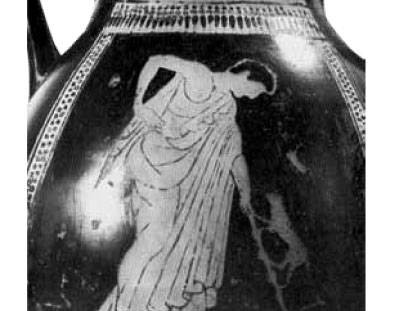Most people are familiar with the strong character of Penelope, who waited at Ithaca while her husband Odysseus was away 20 long years. In Homer’s Odyssey we watch in admiration as she holds together Odysseus’ kingdom and keeps a horde of suitors at bay until he returns. But many readers quickly pass over the fact that she kept a flock of geese to help ease her heart. Indeed, later Greek art often shows women in domestic situations with geese or ducks. Penelope’s geese are just one example of the importance of pets to the ancient Greeks. As illustrated on vases, bowls, jugs, reliefs, figurines, and even funerary stelae, pets and people enjoyed a strong emotional bond.
I have twenty geese here about the house, and they feed on Grains of wheat from the water trough. I love to watch them.
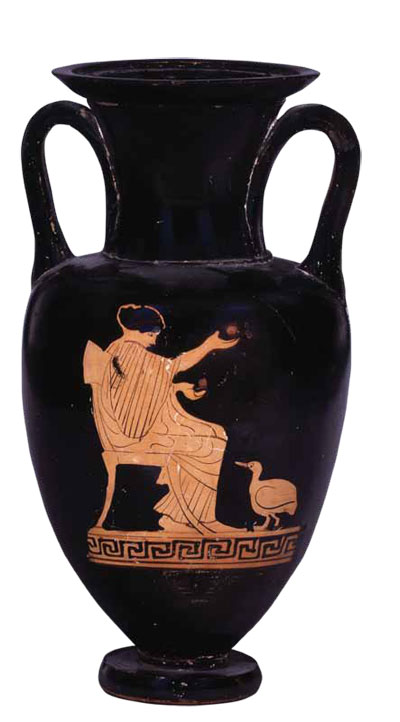
A red figure amphora dating to 470–460 BC shows a woman spending her leisure time playing ball (a ball is in each hand) while a goose looks on (1). A Hellenistic terracotta of the late 4th century BC (2) shows another woman looking into a mirror as she adjusts her dress with the help of an attendant. At her feet sits a goose whose head has unfortunately been lost. Such scenes may have been commonplace in Greek households, with pets nearby during many domestic activities.
Another pet in the Odyssey is justifiably famous—Odysseus’ long-suffering dog. As Odysseus nears his home in a deformed beggar’s disguise provided by Athena, he has fooled everyone he has met. But at the city gates lies an old dog named Argos. Odysseus had raised him but left for Troy before the dog was fully grown. Argos had been a great hunter in his day, but now he is banished outside the gates of Ithaca, lying “in the dung, all covered with dog ticks” (Od. 17.300, trans. Lattimore), no longer useful to those who are making decisions in Odysseus’ absence. He is at least 20 years old—ancient in dog years—but as soon as Odysseus comes near, he sees through the disguise and recognizes his master. In one of the most heart-wrenching scenes from antiquity, the dog—who can no longer walk—lays his ears back, wags his tail, and closes his eyes for the last time. Homer tells us that tears came to Odysseus’ eyes as he watched the dog first welcome him and then die.
Our first instinct is to view both scenes through modern eyes and think of the geese and Argos as family pets. But we must proceed carefully. Odysseus, pretending he does not know Argos, asks his guide whether the dog was a hunter in his day or perhaps “one of the kind of table dog that gentlemen keep, and it is only for show that their masters care for them” (Od. 17.309-10, trans. Lattimore). Herein lies the crux of the problem, because before we talk about the pets of the Greeks, we would be wise to define what a pet actually is. A pet is generally defined as an animal kept for companionship or amusement. But what about companion animals that also serve a practical use such as hunting or guarding, as Argos did? One would also assume that humans do not eat their pets. But did Penelope ever eat her geese? If they were kept for their flesh or eggs, an argument can be made that they were farm animals as well as pets. It is clear, then, that while some animals were kept strictly for emotional reasons, other pets might serve multiple functions.
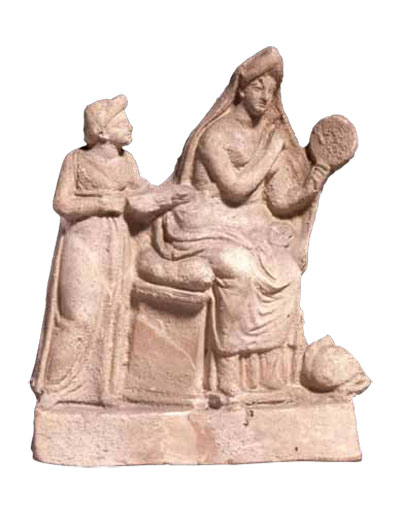
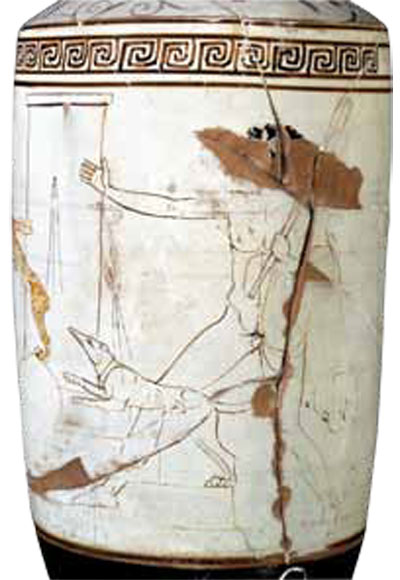
Common Pets
Dogs
Dogs were domesticated early and soon became close companions to humans. Current evidence suggests that dogs were domesticated by ca. 13,000 BC. Cats, on the other hand, are thought to have been domesticated later, about 8,000 BC in the Near East, not Egypt as is commonly thought. Sometimes evidence of human-animal bonds appears in the archaeological record; a late Paleolithic burial in northern Israel dating from about 12,000 years ago yielded the skeleton of an elderly person of uncertain gender who had a hand placed carefully over the skeleton of a puppy.
Mycenaean art frequently includes dogs, and the burial of dogs with humans is a well-known Mycenaean custom. The Ashmolean Museum at the University of Oxford exhibits a Mycenaean rhyton (drinking vessel), dated 1300–1190 BC, in the shape of dog or fox head. By classical Greek times the breeding of dogs had flourished, and D.B. Hull in his Hounds and Hunting in Ancient Greece (1964) patiently collected the names of at least 29 separate breeds, not counting breeds that may have been imported. The ancients mention the Castrian, Molossian, Cretan, Laconian, “fox-dog,” and many more, each with specific traits that made them appealing to humans. Equating these descriptions to modern breeds is difficult, if not impossible, but it is safe to say that Greek dogs fell into three basic categories. The first was a large mastiff-type dog such as the Molossian hound whose job was to guard flocks and fend off wolves.
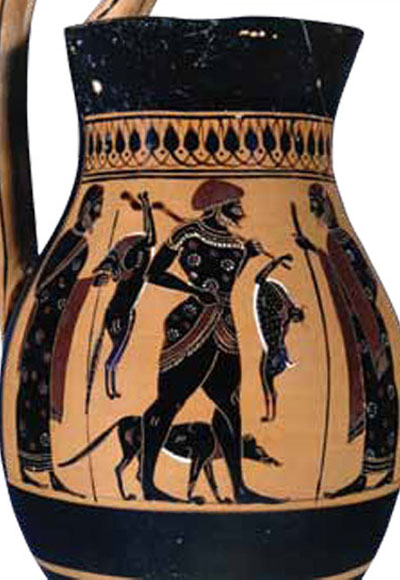
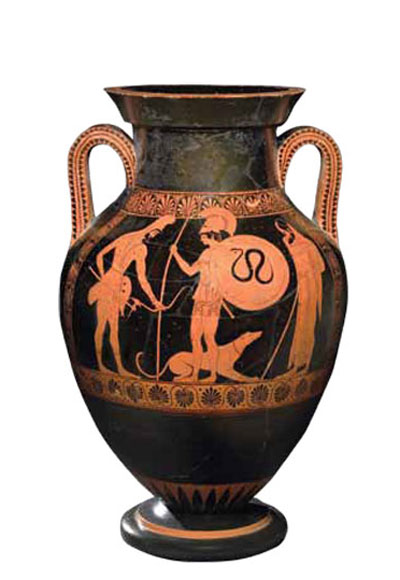
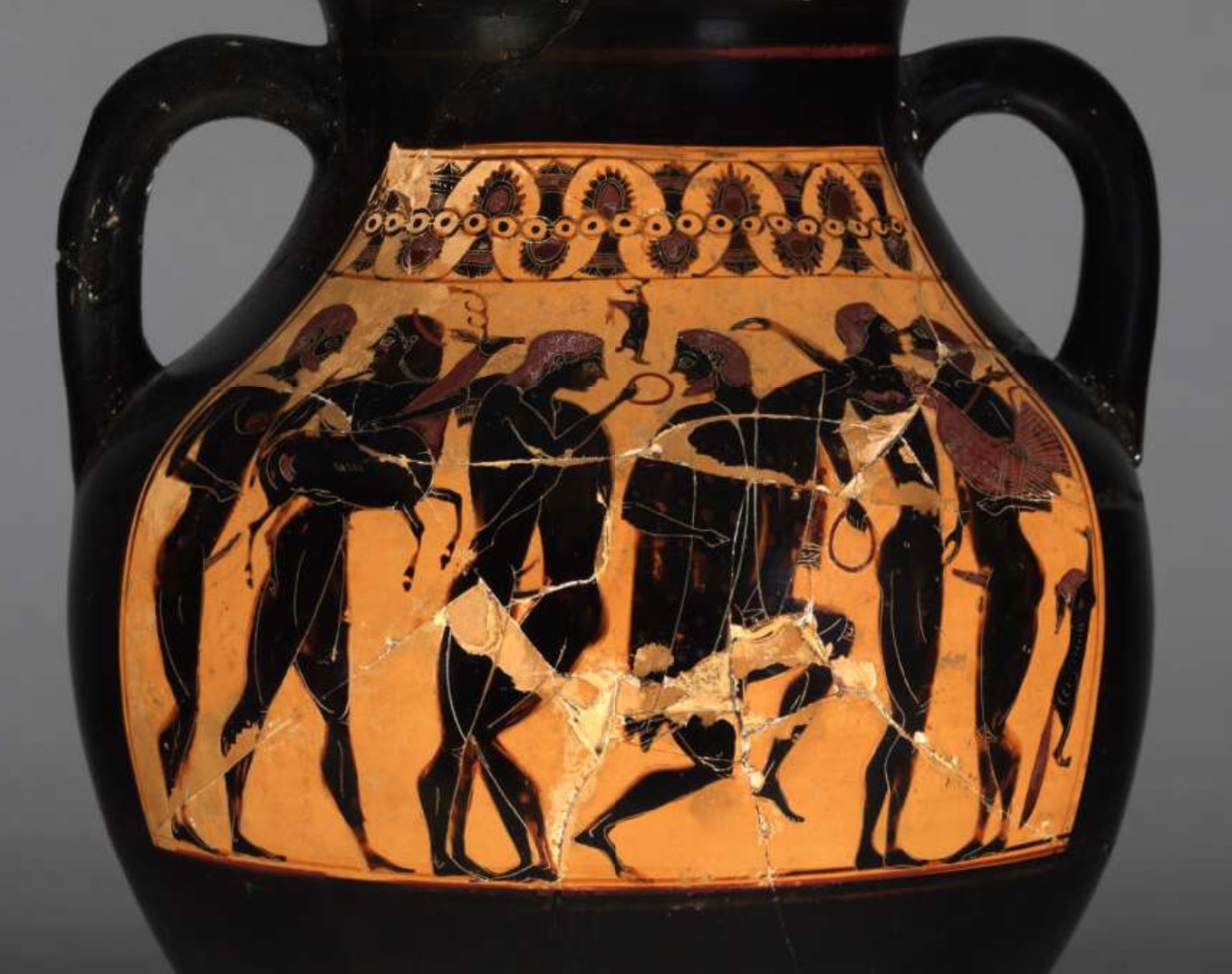
These animals probably spent the majority of their time outside and may not have been considered pets. The second type was used for hunting and was bred for speed, tracking, and tenacity (3). These dogs—the most common were Laconian (Spartan) and Cretan—straddle the line between pet and work animal, for we often see them on Greek vases, accompanying young aristocrats on the hunt for deer, hare, and boar (4).
They are also shown frequently in scenes depicting soldiers departing for war, perhaps indicating the close ties between men and dogs. One such scene (5) is of interest for many reasons (Why is a Phrygian archer here? Why does the old man hold his nose?), but is especially interesting because it clearly shows a dog’s body language. The dog appears nervous or anxious, a state brought on, we are to understand, by the imminent departure of its master. Such dogs were the constant companions of young aristocrats (in some periods described as ephebes), often in public places such as the gymnasium. When these young men are courted by older men—a common social interaction in ancient Athens—“love gifts,” many caught with the help of dogs, are often exchanged. A black figure amphora shows these gifts (6): a deer to the left, a hare hanging on the wall, and a fox to the right. The dogs of young aristocrats commonly wear collars, are often on leashes, and frequently recline under the young men’s couches at symposia, Greek drinking/ dinner parties. So popular was this custom that the sculptor of the Nereid Monument from Lycia even shows King Arbinas with his dog (7). The writer Xenophon, best known for his histories and his works on Socrates, even wrote a treatise called the Kynegitika on the breeding, rearing, and training of just this sort of dog.
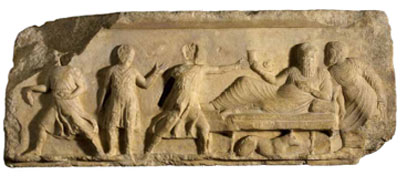
The third type of dog is as much a creature of the house as the Molossian was of the field. These little Maltese definitely fall into the realm of “pet” for they serve no practical purpose other than to provide pleasure and companionship to their owners. In ancient Athens, a three-day festival to Dionysus took place each year called the Anthesteria, which was characterized by great merriment and drinking. During the festival children were given miniature versions of vases called choes (singular chous) which often depicted boys or girls with Maltese dogs. It has been persuasively suggested that children received pets as gifts at the Anthesteria; it is possible that male children were given Maltese dogs when young and then, in a kind of rite of passage, graduated up to a hunting dog, which then accompanied them on the hunt and on social occasions. Other animals are also seen on these choes, many of which are undoubtedly pets.
A chous from the British Museum shows a young boy with two pets: a Maltese and a bird that may represent a jackdaw or a song bird (8). Another charming chous in the British Museum shows a young boy holding a bird and a push toy, perhaps another gift (9). Other choes bear images of roosters, birds that may be ducks or geese, hares, and carts drawn by (pet?) goats and fawns. Roosters, in fact, were commonly kept by aristocratic youths for the purpose of cock fighting (10).
A chous in the Fitzwilliam Museum showing a large water bird pulling a cart may be more fanciful than factual.
Although the Maltese is mostly associated with children and women, it is occasionally shown with an adult male. A famous vase (11) shows a wreathed reveler on his way home from a symposium, singing and playing the lyre, and accompanied by his small pet. Some scholars have even suggested that the figure is Anakreon, a famous 6th century BC lyric poet.
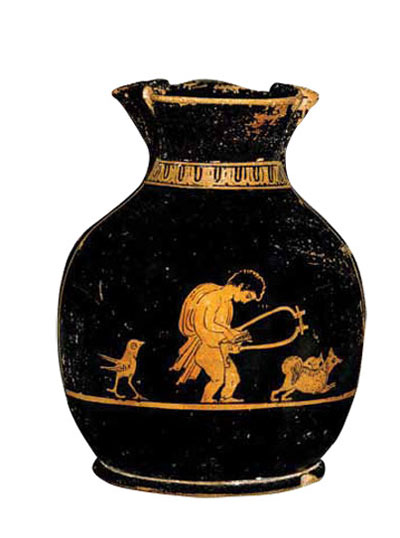
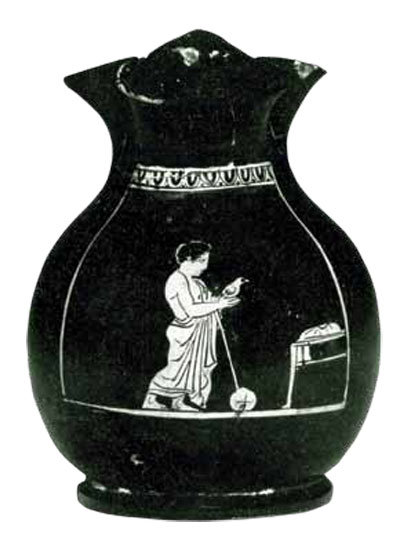
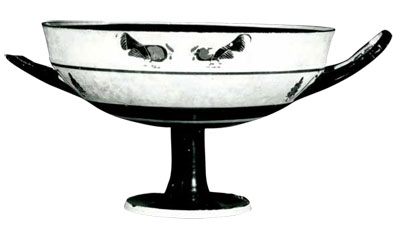
Cats
The question of the cat as a pet in ancient Greece is rather vexing. Modern Athens is home to countless feral cats. However, the status of the cat in ancient Greece is unclear, as images of cats are fairly rare. The Greeks undoubtedly learned of the cat through contact with Egypt where the cat was so beloved that, according to the historian Herodotus, Egyptians shaved off their eyebrows when a pet cat died. But the Greeks seem never to have formed the same depth of attachment to the cat, and references to them are so infrequent in the literature that most scholars think their presence in ancient Greece was minimal.
Cats were probably kept by Greek households as liminal animals—animals that come and go from the house as they wish. This may account for the fact that few cat bones have been found in domestic situations. In Greece the important job of “mouser” seems to have been handled by weasels and ferrets, many of which were also considered liminal pets. Yet some clear representations of cats do exist. The National Archaeological Museum of Athens hosts a famous funerary kouros base (NAM #3476) dating to about 510 BC that shows two seated Athenian noble youths, each holding a pet on a leash, one a cat, the other a dog. Other sides of the base show young men exercising in the gymnasium, and we are left to imagine that each of the seated youths has come to the gymnasium to show off his pet. The arched back of a cat as it faces a dog is familiar to anyone who has ever seen such an encounter.
A funeral stele from Aegina or Salamis dates to 430–420 BC, and with craftsmanship of the highest order, it shows a youth in profile, holding a bird in his left hand and extending his right hand toward a cage (12). Just below the cage is a rectangular pillar, and upon this sits an animal, which—although his head is missing—is almost assuredly a domestic cat. An unusual askos in the shape of a lobster’s claw (13) shows a rather poorly drawn cat. One might take it for a wild cat, but elsewhere on the vessel are a dog and a cock, both of which were likely pets.
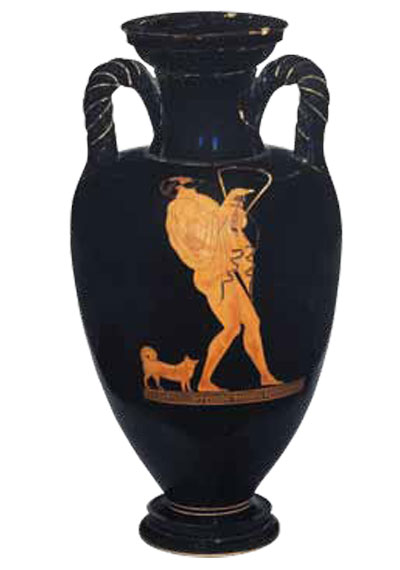
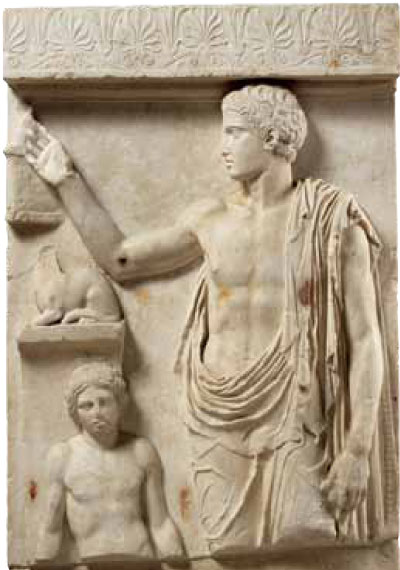
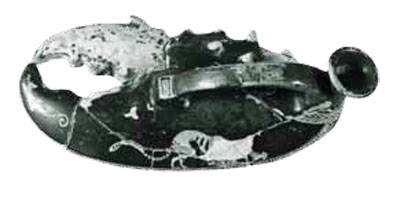
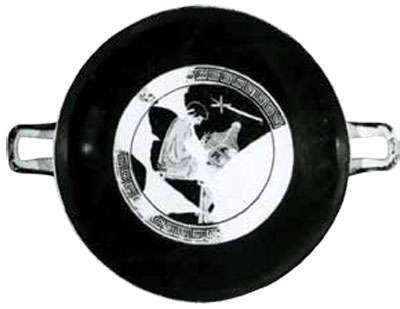
Birds
In addition to the geese described earlier, many birds were kept as pets. Next to dogs, they may have been the second most common type of pet in ancient Greece. The name vase of the Cage Painter (14) clearly shows a bird in a cage being held on a young man’s lap. Was this a personal pet or intended as a gift?
As noted earlier, young children were given birds as pets. Grave stelae of children regularly show them holding a bird, commonly a dove. Many stelae, such as the Melisto stele in the Harvard Sackler Museum (15), show a deceased child holding out a bird to a Maltese dog, as if inviting play. Pet birds are also depicted in happier circumstances. Plutarch and other authors tell us that starlings, crows, and parrots were all kept as pets and that these birds delighted their owners by imitating their voices. Likewise, small songbirds such as sparrows were kept in cages to entertain their owners with their song. Several Greek vases even show long-legged birds such as cranes in the women’s quarters, and the famous Alcibiades had a pet quail.
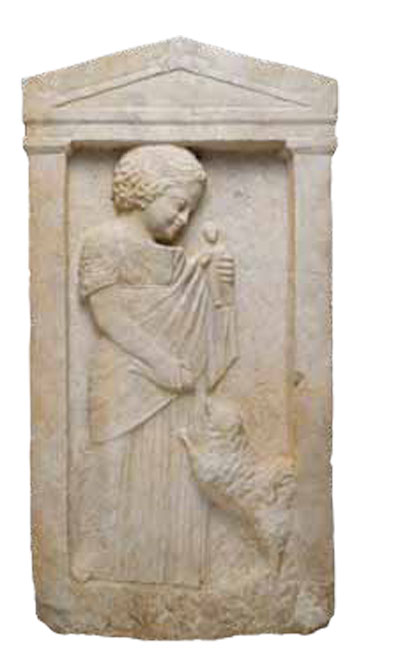
Less Common Pets
Over 30 years ago, Ann Ashmead published “Greek Cats” in this magazine (Expedition 20[3]:38-47). She was inspired by a vase in the Penn Museum (16) which effectively demonstrated that cheetahs were kept by aristocratic youths. The cheetahs may have been purchased from Egypt where they were also kept as pets. Cheetahs on Greek vases are clearly status symbols and often have collars and leashes (17).
A red figure hydria (18) dating to the end of the Persian Wars (middle of the 5th century BC) shows a music lesson to which the students have brought their pets. The Maltese dog beneath the chair is of interest, but one youth, clearly showing off his affluence, is leading a cheetah on a leash. The relative size of the cat compared to the small dog leads us to believe it is still young. Compare this to the music lesson scene on the shoulder of a hydria attributed to the Agrigento painter and dating about ten years after the previous vase (19). Here a young cheetah is on a low table, to be admired by one and all. To the right side of the scene a figure is seated on the ground, leaning on its left side. The features of the figure lead us to believe that this may also be a pet—a monkey or small ape. Although there is scant evidence for simian pets in this period, we know that monkeys and apes were very popular as pets in later antiquity.
A visit to an ancient Greek house might reveal a wide variety of other less traditional pets as well. Grasshoppers, crickets, and cicadas (20) were kept in tiny cages and were valued for their song. The Greek Anthology even has some epitaphs expressly written for such pets upon their demise, and the poet Meleager laments the loss of his cicada after three years of captivity, claiming that its singing helped him sleep and drove away cares. An ancient commentator on a passage from Aristophanes’ Wasps tells us that children would tie a thread to the leg of a beetle and let them buzz through the air. They may have been pets or simply played with and released.
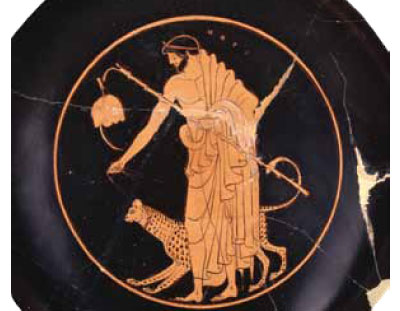
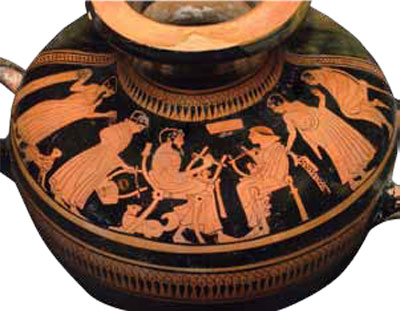
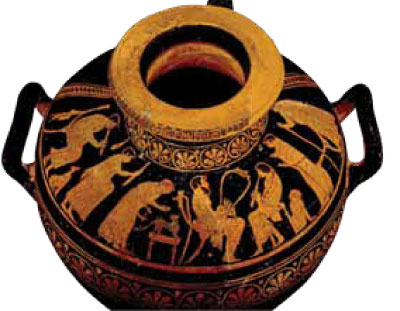
Let us end this section with two animals generally overlooked as pets for the Greeks. The first is the hare. We have seen above that the hare was routinely hunted and presented as a gift. The hare’s fertility and active sex life associate it with Aphrodite and Eros. But evidence exists that the hare was also kept as a pet and not merely presented as a lifeless, tasty morsel to be eaten.
A red-figured cup shows a youth running with a hare (21). A Tanagra figurine shows a girl holding a hare, and the Worcester Art Museum has a fine pyxis which shows Erotes at play, with a hare on a leash (22).
Our last uncommon pet is the hedgehog, which was kept in and around houses, no doubt for its tendency to eat slugs and snails. Aristotle reported that a man in Byzantium kept a hedgehog that earned him a living by forecasting the weather. Hedgehogs build burrows with two entrances and, so it was told, blocked off one of them if bad weather was on the way.
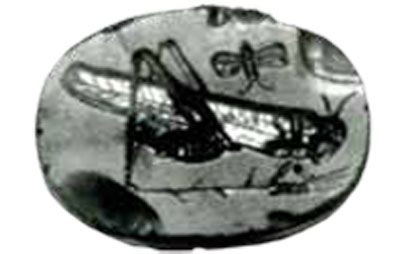
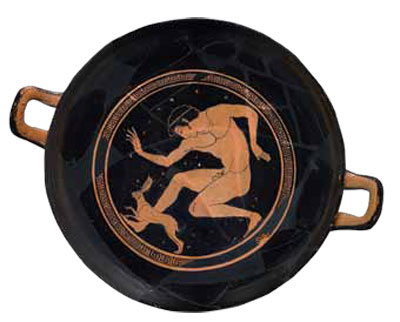
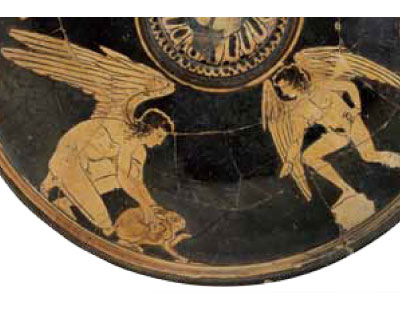
The Treatment of Animals
The number of pets appearing with humans on grave stelae, vases, and other objects is testimony to the fact that many Greeks formed strong emotional attachments to their pets. But were the Greeks enlightened as to animal “rights”? And do we know what their attitude was toward animal cruelty? Although the answers to these questions are not known with certainty, at least we can point to the relative infrequency with which tales of animal abuse appear in the Greek world, as well as the reverse—strong cases indicating respect for pets. Alcibiades, Socrates’ student and the most famous playboy of late 5th century BC Athens,
once paid 70 minae for a dog. A mna (or mina) was worth 100 drachmas, so he paid 7,000 drachmas for the dog. This was a considerable sum, as a skilled laborer at that time earned only about one drachma a day. Plutarch, in writing about the life of Alcibiades, tells us that he had the dog’s tail cut off, which caused great resentment among his friends who said: All of Athens felt sorry for the dog.
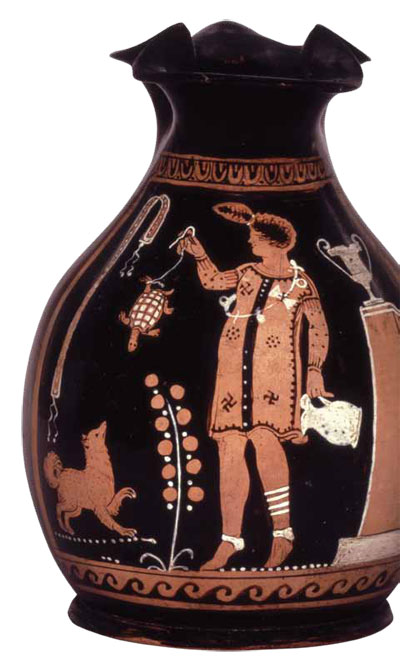
This writer knows of only one vase which depicts animal mistreatment. A late chous (360–350 BC) in the British Museum shows a young girl whirling a turtle about by a string attached to its rear foot, teasing her pet Maltese dog in the process (23). This may be compared to depictions on funeral stelae of children holding birds in the air over leaping Maltese dogs, although these may be construed as scenes of play.
One last anecdote sums up the attachment between the ancient Greeks and their pets. The date was 480 BC, and the Persians under Xerxes were closing in on Athens, which they would soon sack and burn. Themistocles ordered the evacuation of women, children, and the elderly. Among these was Xanthippus, the father of Pericles. Plutarch, in his life of Themistocles, relates that the dogs of Athens ran about howling at being separated from their masters, but the dog of Xanthippus swam after his master’s ship all the way to Salamis. He emerged from the water and promptly died of exhaustion on the shore. Showing his affection for his dedicated pet, Xanthippus buried the dog in a place near the sea that is known even today as the Dog’s Tomb. This brings us full circle, back to the emotion shown by Odysseus for Argos. The ancient Greeks kept a variety of animals for reasons other than utility. They also kept them for the emotional gratification they offered their owners.
Kenneth Kitchell is a Professor in the Department of Classics at the University of Massachusetts Amherst.

